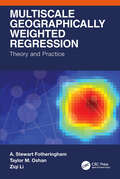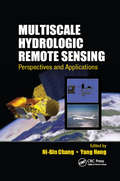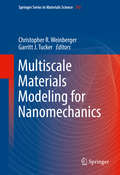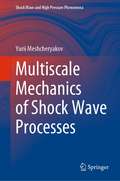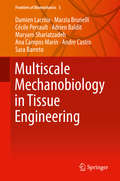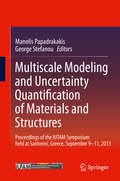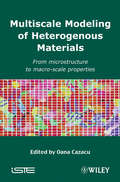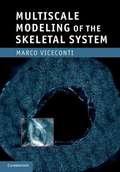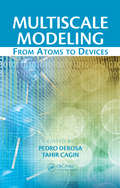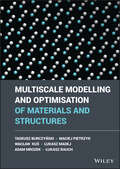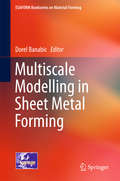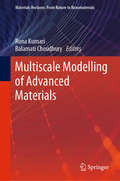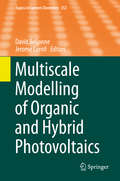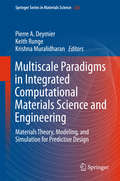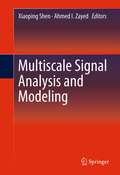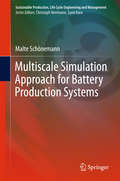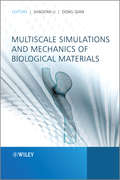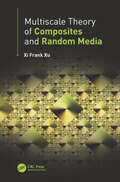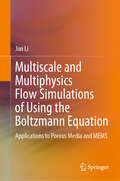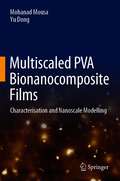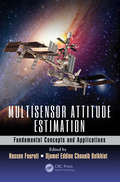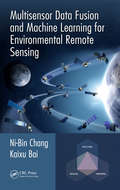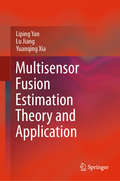- Table View
- List View
Multiscale Geographically Weighted Regression: Theory and Practice
by A. Stewart Fotheringham Taylor M. Oshan Ziqi Li· Provides a balance between conceptual and technical introduction to local models · Explains state-of-the-art spatial analysis technique for multiscale regression modeling · Describes best practices and provides a detailed walkthrough of freely available software, through examples and comparisons with other common spatial data modeling techniques · Includes a detailed case study to demonstrate methods and software · Takes a new and exciting angle on local spatial modeling using MGWR, an innovation to the previous local modeling ‘bible’ GWR
Multiscale Hydrologic Remote Sensing: Perspectives and Applications
by Ni-Bin Chang Yang HongMultiscale Hydrologic Remote Sensing: Perspectives and Applications integrates advances in hydrologic science and innovative remote sensing technologies. Raising the visibility of interdisciplinary research on water resources, it offers a suite of tools and platforms for investigating spatially and temporally continuous hydrological variables and p
Multiscale Materials Modeling for Nanomechanics
by Christopher R. Weinberger Garritt J. TuckerThis book presents a unique combination of chapters that togetherprovide a practical introduction to multiscale modeling applied to nanoscalematerials mechanics. The goal of this book is to present a balancedtreatment of both the theory of the methodology, as well as some practicalaspects of conducting the simulations and models. The first half of thebook covers some fundamental modeling and simulation techniques ranging from ab-inito methods to the continuum scale. Included in this set of methods are several different concurrent multiscalemethods for bridging time and length scales applicable to mechanics at the nanoscaleregime. The second half of the book presents a range of casestudies from a varied selection of research groups focusing either on a the applicationof multiscale modeling to a specific nanomaterial, or novel analysis techniquesaimed at exploring nanomechanics. Readers are also directed tohelpful sites and other resources throughout the book where the simulationcodes and methodologies discussed herein can be accessed. Emphasis on thepracticality of the detailed techniques is especially felt in the latter halfof the book, which is dedicated to specific examples to studynanomechanics and multiscale materials behavior. An instructive avenue forlearning how to effectively apply these simulation tools to solve nanomechanicsproblems is to study previous endeavors. Therefore, each chapter iswritten by a unique team of experts who have used multiscale materials modelingto solve a practical nanomechanics problem. These chapters provide an extensivepicture of the multiscale materials landscape from problem statement throughthe final results and outlook, providing readers with a roadmap forincorporating these techniques into their own research.
Multiscale Mechanics of Shock Wave Processes (Shock Wave and High Pressure Phenomena)
by Yurii MeshcheryakovThis book presents theoretical and experimental investigations of mechanical behavior of solids under shock loading and highlights a multi-scale exchange process of energy and momentum between meso and macroscopic hierarchy. It also widely covers experimental approaches for the multi-scale response of solids to impacts including uniaxial strain conditions and high-velocity penetration processes. The content comprises two parts. The first part overviews modeling and theory of dynamically deformed solids from the multi-scale point of view. The second part describes experimental characterization of shock-induced solids and experimental probing of mesostructured and mesoscale dynamic processes in solids. The theory presented in the first part is then verified as it is compared with i) experiments of shock loading into different kinds of solids and ii) probed microstructure of post-shocked specimens by scanning electron microscopy, transmission electron microscopy and optical microscopy.The text is written on the basis of author’s lectures at universities and thus is concisely described for postgraduate students. It is also useful for researchers who work on the theory of multi-scale mechanics of solids and engineers who work on testing materials under dynamic loading.
Multiscale Mechanobiology in Tissue Engineering (Frontiers of Biomechanics #3)
by Damien Lacroix Marzia Brunelli Cécile Perrault Adrien Baldit Maryam Shariatzadeh Ana Campos Marin Andre Castro Sara BarretoThis book focuses on the mechanobiological principles in tissue engineering with a particular emphasis on the multiscale aspects of the translation of mechanical forces from bioreactors down to the cellular level. The book contributes to a better understanding of the design and use of bioreactors for tissue engineering and the use of mechanical loading to optimize in vitro cell culture conditions. It covers experimental and computational approaches and the combination of both to show the benefits that computational modelling can bring to experimentalists when studying in vitro cell culture within a scaffold. With topics from multidisciplinary fields of the life sciences, medicine, and engineering, this work provides a novel approach to the use of engineering tools for the optimization of biological processes and its application to regenerative medicine. The volume is a valuable resource for researchers and graduate students studying mechanobiology and tissue engineering. For undergraduate students it also provides deep insight into tissue engineering and its use in the design of bioreactors. The book is supplemented with extensive references for all chapters to help the reader to progress through the study of each topic.
Multiscale Modeling and Uncertainty Quantification of Materials and Structures
by Manolis Papadrakakis George StefanouThis book contains the proceedings of the IUTAM Symposium on Multiscale Modeling and Uncertainty Quantification of Materials and Structures that was held at Santorini, Greece, September 9 - 11, 2013. It consists of 20 chapters which are divided in five thematic topics: Damage and fracture, homogenization, inverse problems-identification, multiscale stochastic mechanics and stochastic dynamics. Over the last few years, the intense research activity at micro scale and nano scale reflected the need to account for disparate levels of uncertainty from various sources and across scales. As even over-refined deterministic approaches are not able to account for this issue, an efficient blending of stochastic and multiscale methodologies is required to provide a rational framework for the analysis and design of materials and structures. The purpose of this IUTAM Symposium was to promote achievements in uncertainty quantification combined with multiscale modeling and to encourage research and development in this growing field with the aim of improving the safety and reliability of engineered materials and structures. Special emphasis was placed on multiscale material modeling and simulation as well as on the multiscale analysis and uncertainty quantification of fracture mechanics of heterogeneous media. The homogenization of two-phase random media was also thoroughly examined in several presentations. Various topics of multiscale stochastic mechanics, such as identification of material models, scale coupling, modeling of random microstructures, analysis of CNT-reinforced composites and stochastic finite elements, have been analyzed and discussed. A large number of papers were finally devoted to innovative methods in stochastic dynamics.
Multiscale Modeling of Heterogenous Materials: From Microstructure to Macro-Scale Properties
by Oana CazacuA material's various proprieties is based on its microscopic and nanoscale structures. This book provides an overview of recent advances in computational methods for linking phenomena in systems that span large ranges of time and spatial scales. Particular attention is given to predicting macroscopic properties based on subscale behaviors. Given the book’s extensive coverage of multi-scale methods for modeling both metallic and geologic materials, it will be an invaluable reading for graduate students, scientists, and practitioners alike.
Multiscale Modeling of the Skeletal System
by Marco VicecontiIntegrative approaches to biomedical research promise to advance our understanding of the human body and physiopathology of diseases. In this book, the author focuses on the skeletal system, demonstrating how multiscale modeling can determine the relationship between bone mechanics and disease. Introductory chapters explain the concept of integrative research, what a model is, predictive modeling, and the computational methods used throughout the book. Starting with whole body anatomy, physiology and modeling, subsequent chapters scale down from bone and tissue levels to the cellular level, where the modeling of mechanobiological processes is addressed. Finally, the principles are applied to address truly complex, multiscale interactions. Special attention is given to real-world clinical applications: one in pediatric skeletal oncology and one on the prediction of fracture risks in osteoporotic patients. This book has wide interdisciplinary appeal and is a valuable resource for researchers in mechanical and biomedical engineering, quantitative physiology and computational biology.
Multiscale Modeling: From Atoms to Devices
by PEDRO DEROSA TAHIR CAGINWhile the relevant features and properties of nanosystems necessarily depend on nanoscopic details, their performance resides in the macroscopic world. To rationally develop and accurately predict performance of these systems we must tackle problems where multiple length and time scales are coupled. Rather than forcing a single modeling approach to
Multiscale Modelling and Optimisation of Materials and Structures
by Tadeusz Burczynski Maciej Pietrzyk Waclaw Kus Lukasz Madej Adam Mrozek Lukasz RauchAddresses the very topical, crucial and original subject of parameter identification and optimization within multiscale modeling methods Multiscale Modelling and Optimization of Materials and Structures presents an important and challenging area of research that enables the design of new materials and structures with better quality, strength and performance parameters as well as the creation of reliable models that take into account structural, material and topological properties at different scales. The authors’ approach is four-fold; 1) the basic principles of micro and nano scale modeling techniques; 2) the connection of micro and/or nano scale models with macro simulation software; 3) optimization development in the framework of multiscale engineering and the solution of identification problems; 4) the computer science techniques used in this model and advice for scientists interested in developing their own models and software for multiscale analysis and optimization. The authors present several approaches such as the bridging and homogenization methods, as well as the general formulation of complex optimization and identification problems in multiscale modelling. They apply global optimization algorithms based on robust bioinspired algorithms, proposing parallel and multi-subpopulation approaches in order to speed-up computations, and discuss several numerical examples of multiscale modeling, optimization and identification of composite and functionally graded engineering materials and bone tissues. Multiscale Modelling and Optimization of Materials and Structures is thereby a valuable source of information for young scientists and students looking to develop their own models, write their own computer programs and implement them into simulation systems. Describes micro and nano scale models developed by the authors along with case studies of analysis and optimization Discusses the problems of computing costs, efficiency of information transfer, effective use of the computer memory and several other aspects of development of multiscale models Includes real physical, chemical and experimental studies with modern experimental techniques Provides a valuable source of information for young scientists and students looking to develop their own models, write their own computer programs, and implement them into simulation systems.
Multiscale Modelling in Sheet Metal Forming
by Dorel BanabicThis book gives a unified presentation of the research performed in the field of multiscale modelling in sheet metal forming over the course of more than thirty years by the members of six teams from internationally acclaimed universities. The first chapter is devoted to the presentation of some recent phenomenological yield criteria (BBC 2005 and BBC 2008) developed at the CERTETA center from the Technical University of Cluj-Napoca. An overview on the crystallographic texture and plastic anisotropy is presented in Chapter 2. Chapter 3 is dedicated to multiscale modelling of plastic anisotropy. The authors describe a new hierarchical multi-scale framework that allows taking into account the evolution of plastic anisotropy during sheet forming processes. Chapter 4 is focused on modelling the evolution of voids in porous metals with applications to forming limit curves and ductile fracture. The chapter details the steps needed for the development of dissipation functions and Gurson-type models for non-quadratic anisotropic plasticity criteria like BBC 2005 and those based on linear transformations. Chapter 5 describes advanced models for the prediction of forming limit curves developed by the authors. Chapter 6 is devoted to anisotropic damage in elasto-plastic materials with structural defects. Finally, Chapter 7 deals with modelling of the Portevin-Le Chatelier (PLC) effect. This volume contains contributions from leading researchers from the Technical University of Cluj-Napoca, Romania, the Catholic University of Leuven, Belgium, Clausthal University of Technology, Germany, Amirkabir University of Technology, Iran, the University of Bucharest, Romania, and the Institute of Mathematics of the Romanian Academy, Romania. It will prove useful to postgraduate students, researchers and engineers who are interested in the mechanical modeling and numerical simulation of sheet metal forming processes.
Multiscale Modelling of Advanced Materials (Materials Horizons: From Nature to Nanomaterials)
by Balamati Choudhury Runa KumariThis volume covers the recent advances and research on the modeling and simulation of materials. The primary aim is to take the reader through the mathematical analysis to the theories of electricity and magnetism using multiscale modelling, covering a variety of numerical methods such as finite difference time domain (FDTD), finite element method (FEM) and method of moments. The book also introduces the multiscale Green’s function (GF) method for static and dynamic modelling and simulation results of modern advanced nanomaterials, particularly the two-dimensional (2D) materials. This book will be of interest to researchers and industry professionals working on advanced materials.
Multiscale Modelling of Organic and Hybrid Photovoltaics
by David Beljonne Jerome CornilThe series Topics in Current Chemistry presents critical reviews of the present and future trends in modern chemical research. The scope of coverage is all areas of chemical science including the interfaces with related disciplines such as biology, medicine and materials science. The goal of each thematic volume is to give the non-specialist reader, whether in academia or industry, a comprehensive insight into an area where new research is emerging which is of interest to a larger scientific audience. Each review within the volume critically surveys one aspect of that topic and places it within the context of the volume as a whole. The most significant developments of the last 5 to 10 years are presented using selected examples to illustrate the principles discussed. The coverage is not intended to be an exhaustive summary of the field or include large quantities of data, but should rather be conceptual, concentrating on the methodological thinking that will allow the non-specialist reader to understand the information presented. Contributions also offer an outlook on potential future developments in the field. Review articles for the individual volumes are invited by the volume editors. Readership: research chemists at universities or in industry, graduate students.
Multiscale Paradigms in Integrated Computational Materials Science and Engineering
by Pierre A. Deymier Keith Runge Krishna MuralidharanThis book presents cutting-edge concepts, paradigms, and research highlights in the field of computational materials science and engineering, and provides a fresh, up-to-date perspective on solving present and future materials challenges. The chapters are written by not only pioneers in the fields of computational materials chemistry and materials science, but also experts in multi-scale modeling and simulation as applied to materials engineering. Pedagogical introductions to the different topics and continuity between the chapters are provided to ensure the appeal to a broad audience and to address the applicability of integrated computational materials science and engineering for solving real-world problems.
Multiscale Signal Analysis and Modeling
by Ahmed I. Zayed Xiaoping ShenMultiscale Signal Analysis and Modeling presents recent advances in multiscale analysis and modeling using wavelets and other systems. This book also presents applications in digital signal processing using sampling theory and techniques from various function spaces, filter design, feature extraction and classification, signal and image representation/transmission, coding, nonparametric statistical signal processing, and statistical learning theory.
Multiscale Simulation Approach for Battery Production Systems
by Malte SchönemannAddressing the challenge of improving battery quality while reducing high costs and environmental impacts of the production, this book presents a multiscale simulation approach for battery production systems along with a software environment and an application procedure. Battery systems are among the most important technologies of the 21st century since they are enablers for the market success of electric vehicles and stationary energy storage solutions. However, the performance of batteries so far has limited possible applications. Addressing this challenge requires an interdisciplinary understanding of dynamic cause-effect relationships between processes, equipment, materials, and environmental conditions. The approach in this book supports the integrated evaluation of improvement measures and is usable for different planning horizons. It is applied to an exemplary battery cell production and module assembly in order to demonstrate the effectiveness and potential benefits of the simulation.
Multiscale Simulations and Mechanics of Biological Materials
by Shaofan Li Dong QianMultiscale Simulations and Mechanics of Biological Materials A compilation of recent developments in multiscale simulation and computational biomaterials written by leading specialists in the fieldPresenting the latest developments in multiscale mechanics and multiscale simulations, and offering a unique viewpoint on multiscale modelling of biological materials, this book outlines the latest developments in computational biological materials from atomistic and molecular scale simulation on DNA, proteins, and nano-particles, to meoscale soft matter modelling of cells, and to macroscale soft tissue and blood vessel, and bone simulations. Traditionally, computational biomaterials researchers come from biological chemistry and biomedical engineering, so this is probably the first edited book to present work from these talented computational mechanics researchers. The book has been written to honor Professor Wing Liu of Northwestern University, USA, who has made pioneering contributions in multiscale simulation and computational biomaterial in specific simulation of drag delivery at atomistic and molecular scale and computational cardiovascular fluid mechanics via immersed finite element method.Key features:Offers a unique interdisciplinary approach to multiscale biomaterial modelling aimed at both accessible introductory and advanced levelsPresents a breadth of computational approaches for modelling biological materials across multiple length scales (molecular to whole-tissue scale), including solid and fluid based approaches A companion website for supplementary materials plus links to contributors' websites (www.wiley.com/go/li/multiscale)
Multiscale Solid Mechanics: Strength, Durability, and Dynamics (Advanced Structured Materials #141)
by Holm Altenbach Victor A. Eremeyev Leonid A. IgumnovThis book provides an overview of the current of the state of the art in the multiscale mechanics of solids and structures. It comprehensively discusses new materials, including theoretical and experimental investigations their durability and strength, as well as fractures and damage
Multiscale Theory of Composites and Random Media
by Xi Frank XuThis is the first book to introduce Green-function-based multiscale theory and the corresponding finite element method, which are readily applicable to composites and random media. The methodology is considered to be the one that most effectively tackles the uncertainty of stress propagation in complex heterogeneities of random media, and which presents multiscale theory from distinctive scale separation and scale-coupling viewpoints. <P><P>Deliberately taking a multiscale perspective, it covers scale separation and then scale coupling. Both micromechanics and novel scale-coupling mechanics are described in relation to variational principles and bounds, as well as in the emerging topics on percolation and scale-coupling computation. It gives detail on the different bounds encountered, covering classical second and third order, new fourth order, and innovative ellipsoidal variations. <P><P>Green-function-based multiscale theory is addressed to applications in solid mechanics and transport of complex media ranging from micro- and nano-composites, polycrystals, soils, rocks, cementitious materials, to biological materials. It is useful as a graduate textbook in civil and mechanical engineering and as a reference.
Multiscale and Multiphysics Flow Simulations of Using the Boltzmann Equation: Applications to Porous Media and MEMS
by Jun LiThis book provides a comprehensive introduction to the kinetic theory for describing flow problems from molecular scale, hydrodynamic scale, to Darcy scale. The author presents various numerical algorithms to solve the same Boltzmann-like equation for different applications of different scales, in which the dominant transport mechanisms may differ. This book presents a concise introduction to the Boltzmann equation of the kinetic theory, based on which different simulation methods that were independently developed for solving problems of different fields can be naturally related to each other. Then, the advantages and disadvantages of different methods will be discussed with reference to each other. It mainly covers four advanced simulation methods based on the Boltzmann equation (i.e., direct simulation Monte Carlo method, direct simulation BGK method, discrete velocity method, and lattice Boltzmann method) and their applications with detailed results. In particular, many simulations are included to demonstrate the applications for both conventional and unconventional reservoirs. With the development of high-resolution CT and high-performance computing facilities, the study of digital rock physics is becoming increasingly important for understanding the mechanisms of enhanced oil and gas recovery. The advanced methods presented here have broad applications in petroleum engineering as well as mechanical engineering , making them of interest to researchers, professionals, and graduate students alike. At the same time, instructors can use the codes at the end of the book to help their students implement the advanced technology in solving real industrial problems.
Multiscaled PVA Bionanocomposite Films: Characterisation and Nanoscale Modelling
by Yu Dong Mohanad MousaThis book highlights a novel and holistic approach to multiscaled PVA bionanocomposite films used for electrical sensing, medical and packaging applications. With a combination of material characterization and modeling to understand the effect of nanoparticle size and shape, as well as 3D interphase properties and features such as interphase modulus and nanoscale dimensions, this book substantiates how excellent mechanical and thermal properties of these materials are achieved. Also it addresses the importance of using economical and ecofriendly bionanocomposites as potential green materials to support the goal of environmental sustainability with multifunctional properties.
Multisensor Attitude Estimation: Fundamental Concepts and Applications (Devices, Circuits, and Systems)
by Hassen Fourati, Djamel Eddine Chouaib Belkhiat and Krzysztof IniewskiThere has been an increasing interest in multi-disciplinary research on multisensor attitude estimation technology driven by its versatility and diverse areas of application, such as sensor networks, robotics, navigation, video, biomedicine, etc. Attitude estimation consists of the determination of rigid bodies’ orientation in 3D space. This research area is a multilevel, multifaceted process handling the automatic association, correlation, estimation, and combination of data and information from several sources. Data fusion for attitude estimation is motivated by several issues and problems, such as data imperfection, data multi-modality, data dimensionality, processing framework, etc. While many of these problems have been identified and heavily investigated, no single data fusion algorithm is capable of addressing all the aforementioned challenges. The variety of methods in the literature focus on a subset of these issues to solve, which would be determined based on the application in hand. Historically, the problem of attitude estimation has been introduced by Grace Wahba in 1965 within the estimate of satellite attitude and aerospace applications. This book intends to provide the reader with both a generic and comprehensive view of contemporary data fusion methodologies for attitude estimation, as well as the most recent researches and novel advances on multisensor attitude estimation task. It explores the design of algorithms and architectures, benefits, and challenging aspects, as well as a broad array of disciplines, including: navigation, robotics, biomedicine, motion analysis, etc. A number of issues that make data fusion for attitude estimation a challenging task, and which will be discussed through the different chapters of the book, are related to: 1) The nature of sensors and information sources (accelerometer, gyroscope, magnetometer, GPS, inclinometer, etc.); 2) The computational ability at the sensors; 3) The theoretical developments and convergence proofs; 4) The system architecture, computational resources, fusion level.
Multisensor Data Fusion and Machine Learning for Environmental Remote Sensing
by Ni-Bin Chang Kaixu BaiIn the last few years the scientific community has realized that obtaining a better understanding of interactions between natural systems and the man-made environment across different scales demands more research efforts in remote sensing. An integrated Earth system observatory that merges surface-based, air-borne, space-borne, and even underground sensors with comprehensive and predictive capabilities indicates promise for revolutionizing the study of global water, energy, and carbon cycles as well as land use and land cover changes. The aim of this book is to present a suite of relevant concepts, tools, and methods of integrated multisensor data fusion and machine learning technologies to promote environmental sustainability. The process of machine learning for intelligent feature extraction consists of regular, deep, and fast learning algorithms. The niche for integrating data fusion and machine learning for remote sensing rests upon the creation of a new scientific architecture in remote sensing science that is designed to support numerical as well as symbolic feature extraction managed by several cognitively oriented machine learning tasks at finer scales. By grouping a suite of satellites with similar nature in platform design, data merging may come to help for cloudy pixel reconstruction over the space domain or concatenation of time series images over the time domain, or even both simultaneously. Organized in 5 parts, from Fundamental Principles of Remote Sensing; Feature Extraction for Remote Sensing; Image and Data Fusion for Remote Sensing; Integrated Data Merging, Data Reconstruction, Data Fusion, and Machine Learning; to Remote Sensing for Environmental Decision Analysis, the book will be a useful reference for graduate students, academic scholars, and working professionals who are involved in the study of Earth systems and the environment for a sustainable future. The new knowledge in this book can be applied successfully in many areas of environmental science and engineering.
Multisensor Data Fusion: From Algorithms and Architectural Design to Applications (Devices, Circuits, and Systems #43)
by Hassen FouratiMultisensor Data Fusion: From Algorithms and Architectural Design to Applications covers the contemporary theory and practice of multisensor data fusion, from fundamental concepts to cutting-edge techniques drawn from a broad array of disciplines. Featuring contributions from the world’s leading data fusion researchers and academicians, this authoritative book: Presents state-of-the-art advances in the design of multisensor data fusion algorithms, addressing issues related to the nature, location, and computational ability of the sensors Describes new materials and achievements in optimal fusion and multisensor filters Discusses the advantages and challenges associated with multisensor data fusion, from extended spatial and temporal coverage to imperfection and diversity in sensor technologies Explores the topology, communication structure, computational resources, fusion level, goals, and optimization of multisensor data fusion system architectures Showcases applications of multisensor data fusion in fields such as medicine, transportation's traffic, defense, and navigation Multisensor Data Fusion: From Algorithms and Architectural Design to Applications is a robust collection of modern multisensor data fusion methodologies. The book instills a deeper understanding of the basics of multisensor data fusion as well as a practical knowledge of the problems that can be faced during its execution.
Multisensor Fusion Estimation Theory and Application
by Yuanqing Xia Lu Jiang Liping YanThis book focuses on the basic theory and methods of multisensor data fusion state estimation and its application. It consists of four parts with 12 chapters. In Part I, the basic framework and methods of multisensor optimal estimation and the basic concepts of Kalman filtering are briefly and systematically introduced. In Part II, the data fusion state estimation algorithms under networked environment are introduced. Part III consists of three chapters, in which the fusion estimation algorithms under event-triggered mechanisms are introduced. Part IV consists of two chapters, in which fusion estimation for systems with non-Gaussian but heavy-tailed noises are introduced. The book is primarily intended for researchers and engineers in the field of data fusion and state estimation. It also benefits for both graduate and undergraduate students who are interested in target tracking, navigation, networked control, etc.
